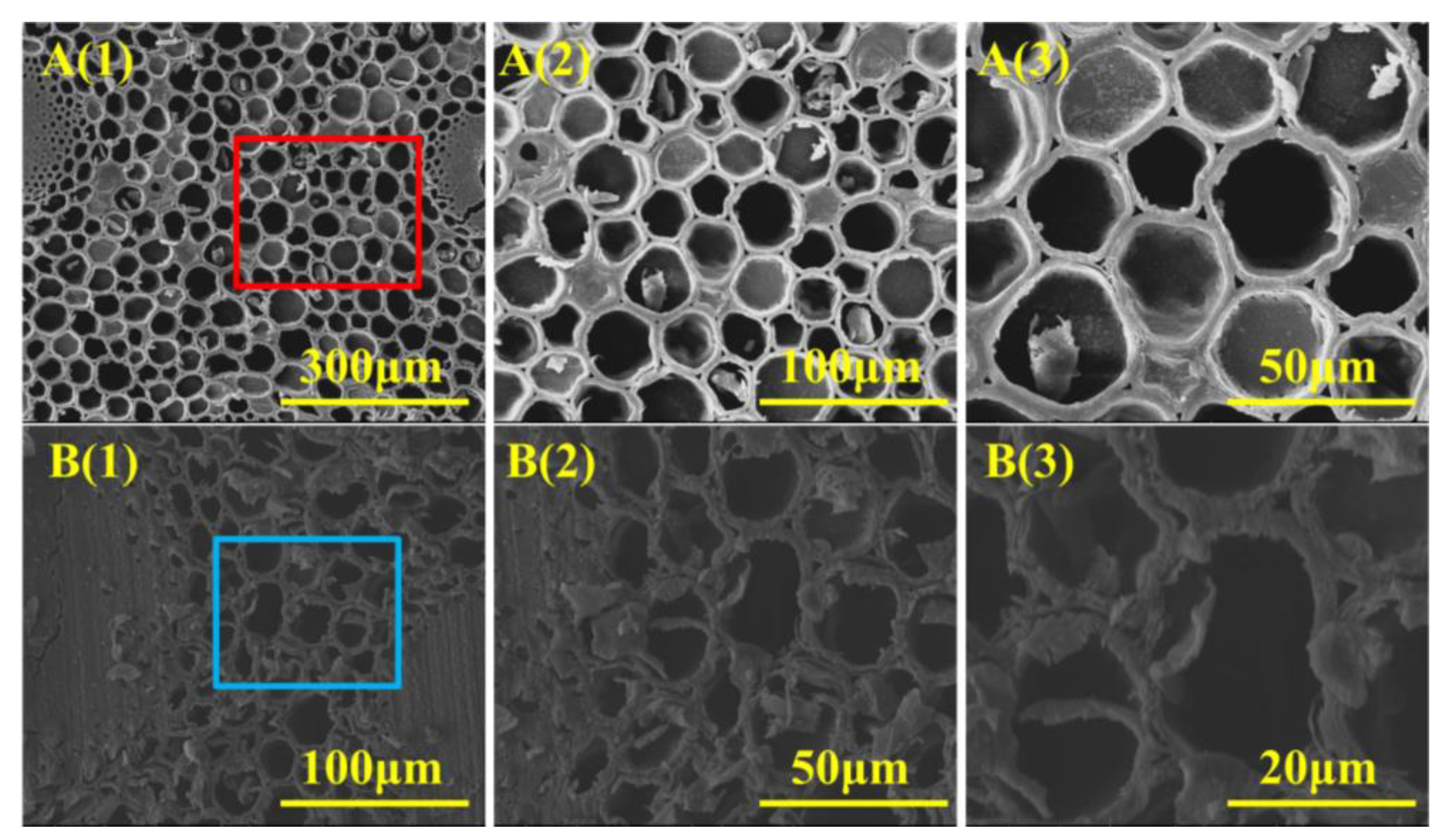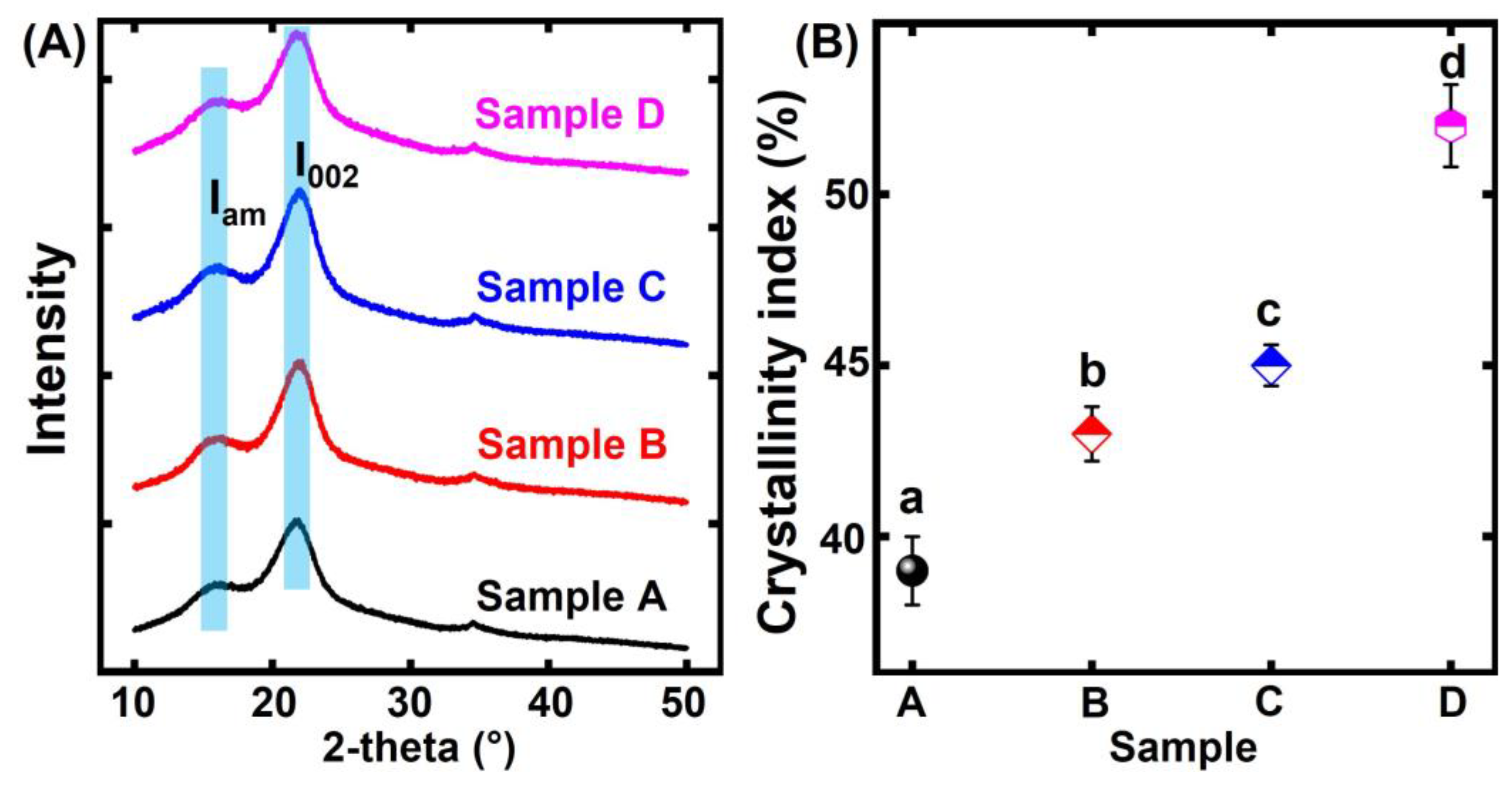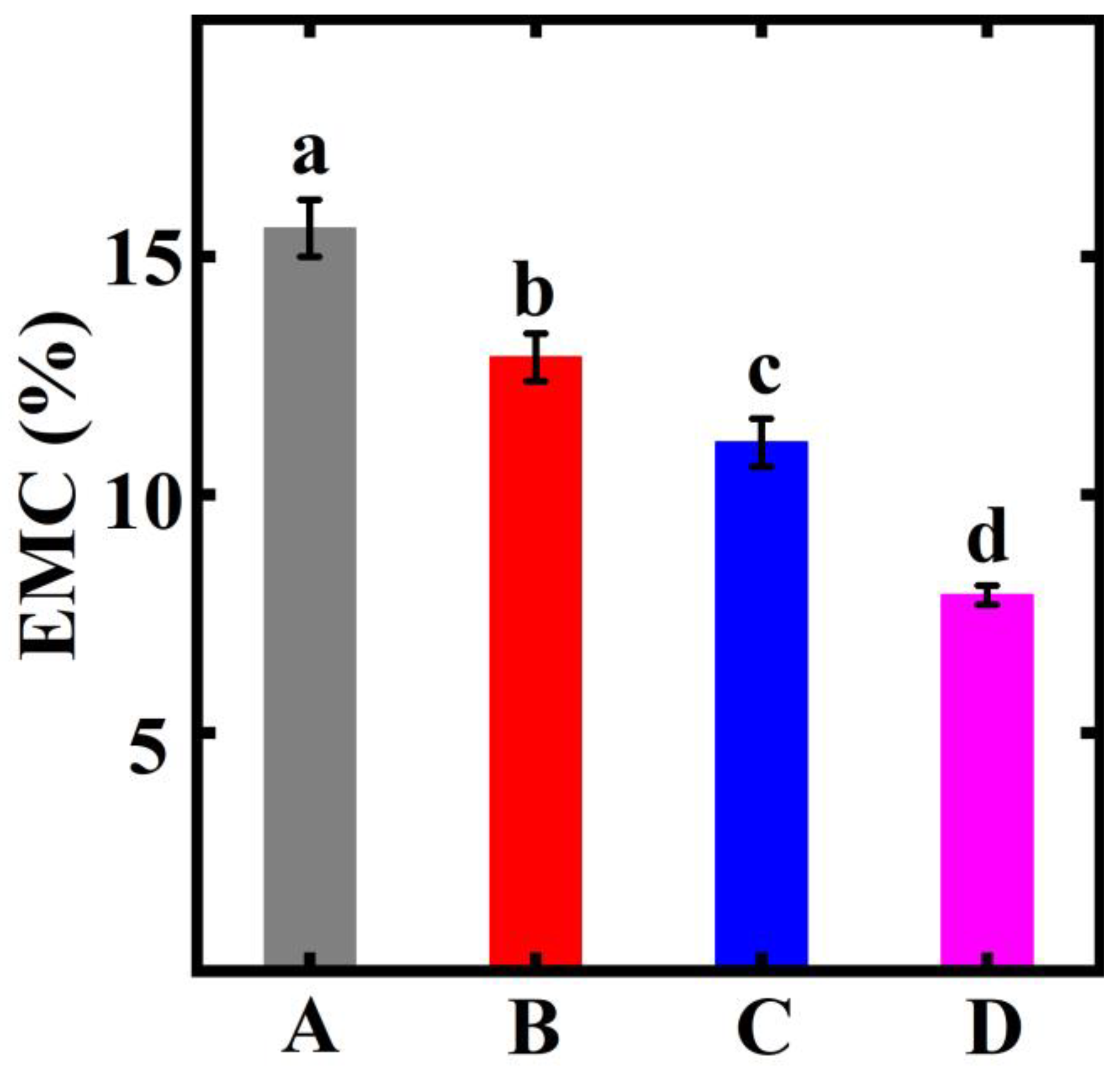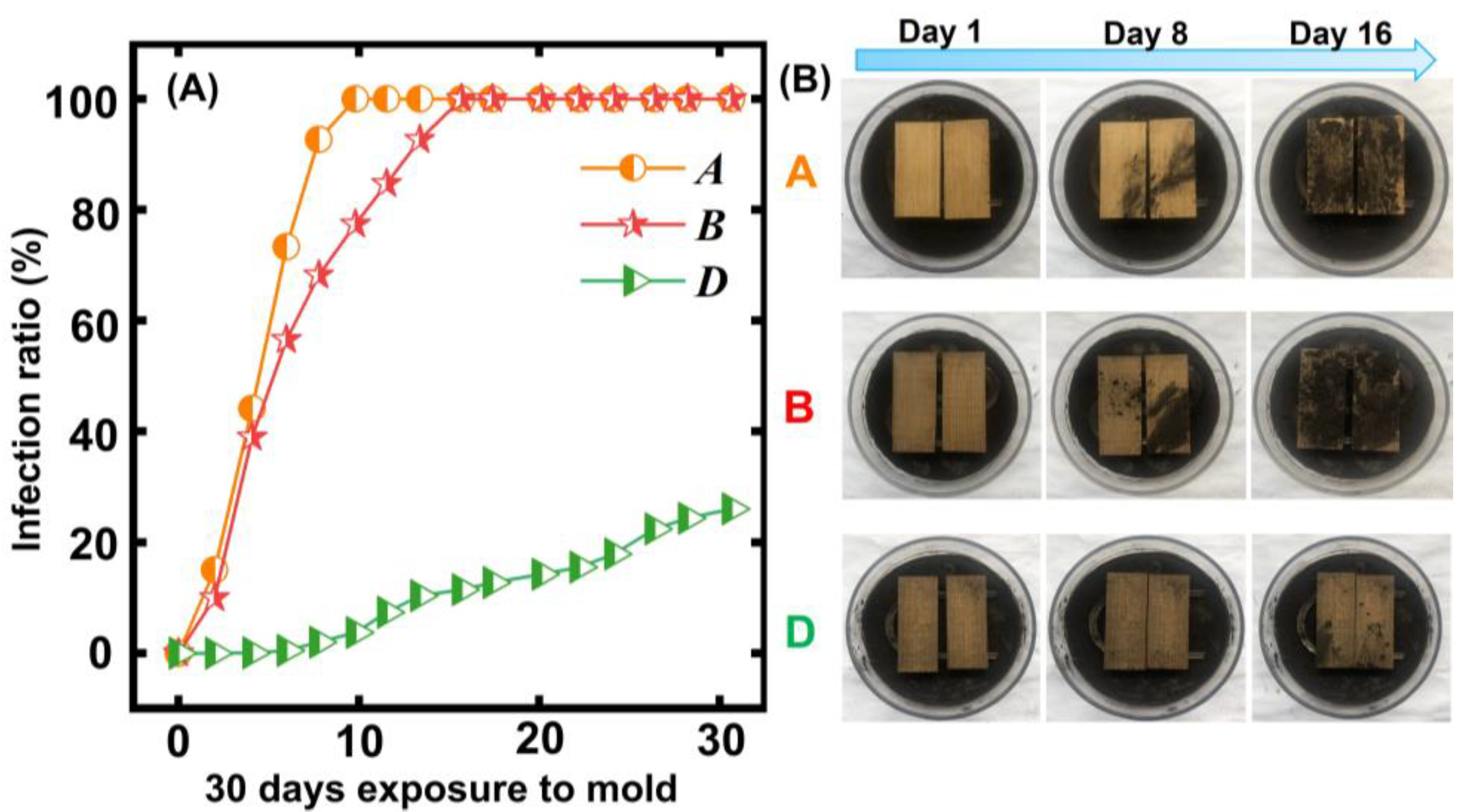Research on the Change in Chemical Composition and Fungal Resistance of Moso Bamboo with Heat Treatment
Abstract
:1. Introduction
2. Materials and Methods
2.1. Sample Preparation
2.2. Scanning Electron Microscopy
2.3. Measurement of the Main Chemical Compositions of the Bamboo
2.4. XPS
2.5. Fourier Transform Infrared (FTIR)
2.6. Anti-Mildew Property Test
2.7. Statistical Analysis
3. Results and Discussion
3.1. Micromorphology Analysis
3.2. XRD Analysis
3.3. Chemical Components Analysis
3.4. FTIR Analysis
3.5. XPS Analysis
3.6. EMC Analysis
3.7. Mold-Resistant PROPERTY Analysis
4. Conclusions
Author Contributions
Funding
Institutional Review Board Statement
Data Availability Statement
Conflicts of Interest
References
- Yuan, T.; Wang, X.; Liu, X.; Li, Y. Dynamic Response of Arc-Shaped Bamboo Sheets during Flattening Process. Ind. Crops Prod. 2023, 192, 116073. [Google Scholar] [CrossRef]
- Xie, X.; Yuan, T.; Yao, Y.; Li, G.; Li, Y.; Wang, X. Phytic Acid-Based Hybrid Complexes for Improving the Interfacial Property and Mildew-Resistance of Heat-Treated Bamboo. Colloids Surf. A Physicochem. Eng. Asp. 2023, 659, 130749. [Google Scholar] [CrossRef]
- Xie, X.; Xi, J.; Dai, Y.; Yuan, T.; Li, Y.; Wang, X. Improving Biomass-Degradation Properties and Nano-Mechanics of Moso Bamboo via a Simple Nitrogen Heat Treatment. Forests 2022, 13, 2059. [Google Scholar] [CrossRef]
- Xiao, X.; Liang, X.; Peng, H.; Wang, K.; Liu, X.; Li, Y. Multi-Scale Evaluation of the Effect of Thermal Modification on Chemical Components, Dimensional Stability, and Anti-Mildew Properties of Moso Bamboo. Polymers 2022, 14, 4677. [Google Scholar] [CrossRef] [PubMed]
- Liang, X.; Yao, Y.; Xiao, X.; Liu, X.; Wang, X.; Li, Y. Pressure-Steam Heat Treatment-Enhanced Anti-Mildew Property of Arc-Shaped Bamboo Sheets. Polymers 2022, 14, 3644. [Google Scholar] [CrossRef] [PubMed]
- Liu, X.; Xiao, X.; Zhang, T.; Li, Y.; Peng, H.; Dong, Y.; Wang, K.; Li, J. Construction of Thorough Cross-Linked Networks in Soybean Meal Adhesive System by Biomimetic Boronic Acid-Anchored Cellulose Nanofibril for Multifunctionality of High-Performance, Mildew Resistance, Anti-Bacterial, and Flame Resistance. Ind. Crops Prod. 2022, 180, 114791. [Google Scholar] [CrossRef]
- Yuan, T.; Wang, X.; Liu, X.; Lou, Z.; Mao, S.; Li, Y. Bamboo Flattening Technology Ebables Efficient and Value-Added Utilization of Bamboo in the Manufacture of Furniture and Engineered Composites. Compos. Part B Eng. 2022, 242, 110097. [Google Scholar] [CrossRef]
- Yuan, T.; Yin, X.; Huang, Y.; Li, X.; Wang, X.; Chen, L.; Li, Y. Hydrothermal Treatment of Bamboo and Its Effect on Nano-Mechanic and Anti-Mildew Property. J. Clean. Prod. 2022, 380, 135189. [Google Scholar] [CrossRef]
- Chen, K.; Tan, Y.; Sun, F.; Zhu, J.; Peng, H.; Jiang, J.; Lyu, J.; Zhan, T. Influence of Electrochemically Deposited TiO 2 on the Anti-Weathering Properties of Heat-Treated Wood. Wood Mater. Sci. Eng. 2022, 72, 1–9. [Google Scholar] [CrossRef]
- Kuai, B.; Wang, Z.; Gao, J.; Tong, J.; Zhan, T.; Zhang, Y.; Lu, J.; Cai, L. Development of Densified Wood with High Strength and Excellent Dimensional Stability by Impregnating Delignified Poplar by Sodium Silicate. Constr. Build. Mater. 2022, 344, 128282. [Google Scholar] [CrossRef]
- Kuai, B.; Tong, J.; Zhang, Y.; Zhan, T.; Lu, J.; Cai, L. Analysis of Micro-Morphology, Mechanical Properties, and Dimensional Stability of Densified Faber Fir Infused with Paraffin. Holzforschung 2022, 76, 451–462. [Google Scholar] [CrossRef]
- Kamperidou, V. Chemical and Structural Characterization of Poplar and Black Pine Wood Exposed to Short Thermal Modification. DRV Ind. 2021, 72, 155–167. [Google Scholar] [CrossRef]
- Gao, J.; Wang, X.; Tong, J.; Kuai, B.; Wang, Z.; Zhang, Y.; Li, G.; Huang, Z.; Cai, L. Large Size Translucent Wood Fiber Reinforced PMMA Porous Composites with Excellent Thermal, Acoustic and Energy Absorption Properties. Compos. Commun. 2022, 30, 101059. [Google Scholar] [CrossRef]
- Liu, Z.; Wen, L.; Wang, X.; Zhang, Y.; Cai, L. Leachability of ACQ-D after Three Different Preservative Treatments. Wood Res. 2020, 65, 591–604. [Google Scholar] [CrossRef]
- Han, S.; Chen, F.; Li, H.; Wang, G. Effect of Off-Axis Angle on Tension Failures of Laminated Moso Bamboo-Poplar Veneer Composites: An in Situ Characterization. Mater. Des. 2021, 212, 110254. [Google Scholar] [CrossRef]
- Chen, L.-S.; Fei, B.-H.; Ma, X.-X.; Lu, J.-P.; Fang, C.-H. Effects of Hygrothermal Environment in Cooling Towers on the Chemical Composition of Bamboo Grid Packing. Forests 2019, 10, 274. [Google Scholar] [CrossRef] [Green Version]
- Wei, X.; Wang, G.; Chen, X.; Jiang, H.; Smith, L.M. Natural Bamboo Coil Springs with High Cyclic-Compression Durability Fabricated via a Hydrothermal-Molding-Fixing Method. Ind. Crops Prod. 2022, 184, 115055. [Google Scholar] [CrossRef]
- Lian, C.; Liu, R.; Zhang, S.; Yuan, J.; Luo, J.; Yang, F.; Fei, B. Ultrastructure of Parenchyma Cell Wall in Bamboo (Phyllostachys Edulis) Culms. Cellulose 2020, 27, 7321–7329. [Google Scholar] [CrossRef]
- Yang, K.; Li, X.; Wu, Y.; Zheng, X. A Simple, Effective and Inhibitor-free Thermal Treatment for Enhancing Mold-proof Property of Bamboo Scrimber. Eur. J. Wood Prod. 2021, 79, 1049–1055. [Google Scholar] [CrossRef]
- Fan, Q.; Ou, R.; Hao, X.; Deng, Q.; Liu, Z.; Sun, L.; Zhang, C.; Guo, C.; Bai, X.; Wang, Q. Water-Induced Self-Assembly and In Situ Mineralization within Plant Phenolic Glycol-Gel toward Ultrastrong and Multifunctional Thermal Insulating Aerogels. ACS Nano 2022, 16, 9062–9076. [Google Scholar] [CrossRef] [PubMed]
- Chen, Y.; Li, H.; Yang, D.; Lorenzo, R.; Yuan, C. Experimental Evaluation of the Dowel-Bearing Strength of Laminated Flattened-Bamboo Lumber Perpendicular to Grain. Constr. Build. Mater. 2022, 350, 128791. [Google Scholar] [CrossRef]
- Zhang, X.; Luo, L.; Xie, X.; Zhang, Y.; Li, Z. Flexural Bearing Capacity and Stiffness of Stiffened Hollow Glulam Beams: Experiments, Finite Element Analysis and Calculation Theory. Constr. Build. Mater. 2022, 345, 128407. [Google Scholar] [CrossRef]
- Yuan, T.; Wang, X.; Lou, Z.; Zhang, T.; Han, X.; Wang, Z.; Hao, X.; Li, Y. Comparison of the Fabrication Process and Macro and Micro Properties of Two Types of Crack-Free, Flatten Bamboo Board. Constr. Build. Mater. 2022, 317, 125949. [Google Scholar] [CrossRef]
- Li, T.; Li, G.; Li, J.; Li, X.; Li, M.; Li, Y. HS-SPME and GC–MS for the Analysis of Odorous Constituents from Heat-Treated Rubberwood and the Chemical Change of Heat-Treated Rubberwood by XPS Analysis. Wood Sci. Technol. 2021, 55, 361–378. [Google Scholar] [CrossRef]
- Chen, Q.; Wei, P.; Tang, T.; Fang, C.; Fei, B. Quantitative Visualization of Weak Layers in Bamboo at the Cellular and Subcellular Levels. ACS Appl. Bio Mater. 2020, 3, 7087–7094. [Google Scholar] [CrossRef] [PubMed]
- Yuan, T.; Wang, Z.; Han, X.; Yuan, Z.; Wang, X.; Li, Y. Multi-Scale Evaluation of the Effect of Saturated Steam on the Micromechanical Properties of Moso Bamboo. Holzforschung 2021, 75, 1052–1060. [Google Scholar] [CrossRef]
- Yuan, T.; Xiao, X.; Zhang, T.; Yuan, Z.; Wang, X.; Li, Y. Preparation of Crack-Free, Non-Notched, Flattened Bamboo Board and Its Physical and Mechanical Properties. Ind. Crops Prod. 2021, 174, 114218. [Google Scholar] [CrossRef]
- Wu, Y.; Zheng, Y.; Yang, F.; Yang, L. Preparation Process and Characterization of Mechanical Properties of Twisted Bamboo Spun Fiber Bundles. J. Mater. Res. Technol. 2021, 14, 2131–2139. [Google Scholar] [CrossRef]
- Jiang, X.; Wan, W.; Wang, B.; Zhang, L.; Yin, L.; Van Bui, H.; Xie, J.; Zhang, L.; Lu, H.; Deng, L. Enhanced Anti-Corrosion and Microwave Absorption Performance with Carbonyl Iron Modified by Organic Fluorinated Chemicals. Appl. Surf. Sci. 2022, 572, 151320. [Google Scholar] [CrossRef]
- Kumar, R.; Gunjal, J.; Chauhan, S. Effect of Carbonization Temperature on Properties of Natural Fiber and Charcoal Filled Hybrid Polymer Composite. Compos. Part B Eng. 2021, 217, 108846. [Google Scholar] [CrossRef]
- Dai, S.-W.; Gu, Y.-L.; Zhao, L.; Zhang, W.; Gao, C.-H.; Wu, Y.-X.; Shen, S.-C.; Zhang, C.; Kong, T.-T.; Li, Y.-T.; et al. Bamboo-Inspired Mechanically Flexible and Electrically Conductive Polydimethylsiloxane Foam Materials with Designed Hierarchical Pore Structures for Ultra-Sensitive and Reliable Piezoresistive Pressure Sensor. Compos. Part B Eng. 2021, 225, 109243. [Google Scholar] [CrossRef]






| Sample | Hemicellulose (%) | Cellulose (%) | Lignin (%) |
|---|---|---|---|
| Sample A | 20.5 (0.1) | 46.9 (0.1) | 24.5 (0.1) |
| Sample B | 19.6 (0.1) | 45.7 (0.2) | 26.6 (0.2) |
| Sample C | 18.9 (0.2) | 44.8 (0.1) | 28.5 (0.2) |
| Sample D | 18.1 (0.3) | 42.6 (0.3) | 31.3 (0.3) |
| Specimen | O/C | C1 | C2 | C3 | C4 | O1 | O1 |
|---|---|---|---|---|---|---|---|
| Sample A | 0.55 | 36.5 | 51.3 | 10.5 | 1.7 | 93.8 | 6.2 |
| Sample D | 0.31 | 49.6 | 40.3 | 8.9 | 1.2 | 92.8 | 7.2 |
Disclaimer/Publisher’s Note: The statements, opinions and data contained in all publications are solely those of the individual author(s) and contributor(s) and not of MDPI and/or the editor(s). MDPI and/or the editor(s) disclaim responsibility for any injury to people or property resulting from any ideas, methods, instructions or products referred to in the content. |
© 2023 by the authors. Licensee MDPI, Basel, Switzerland. This article is an open access article distributed under the terms and conditions of the Creative Commons Attribution (CC BY) license (https://creativecommons.org/licenses/by/4.0/).
Share and Cite
Yu, W.; Wang, Y. Research on the Change in Chemical Composition and Fungal Resistance of Moso Bamboo with Heat Treatment. Polymers 2023, 15, 453. https://doi.org/10.3390/polym15020453
Yu W, Wang Y. Research on the Change in Chemical Composition and Fungal Resistance of Moso Bamboo with Heat Treatment. Polymers. 2023; 15(2):453. https://doi.org/10.3390/polym15020453
Chicago/Turabian StyleYu, Wangwang, and Yong Wang. 2023. "Research on the Change in Chemical Composition and Fungal Resistance of Moso Bamboo with Heat Treatment" Polymers 15, no. 2: 453. https://doi.org/10.3390/polym15020453





